Improving upon Nature: Beauty Training in the Regency Era
Beauty Training
Improving upon nature
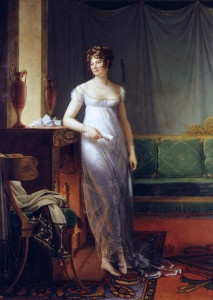
Catherine Worlée, Princesse de Talleyrand-Périgord (1762-1834)
*oil on canvas
*226 × 165 cm
*1804-1805
With so much at stake, success in the marriage mart not the least consideration, suggestions abounded as to how a young woman might improve her natural beauty. Recommendations were not dissimilar to those we see today, including medicinal options, diet, exercise and cosmeseutical preparations.
Medicinal Preparations
The digestive system was seen as the source of a great many ills. Those seeking a beautiful form were cautioned to attend carefully to the “stomach and bowels, as the prevalence of acidity or of costiveness will render all…other exertions useless.” (Corbould,1825) Laxative pills, acidity remedies, and even ‘spinal’ pills were suggested, with popular remedies offered for the improvement of health and spinal distortions.
One such recipe, Dr. Jarrold’s Spinal Pills, recommended taking one drachm of burnt sponge, fifty grains of carbonate of soda to be mixed and divided into divide into twenty pills; three to be taken for a dose, twice a day; and the bowels kept open by laxatives, for six weeks or two months. (Corbould,1825)
Beauty training
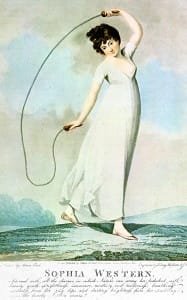 For those who sought more than pills and other nostrums could offer, beauty training might provide desired results. The process, which promised to ‘restore at least five or ten years of vanished charms’ and insure an addition ten years of began with clearing the stomach and bowels with emetics and purgatives—reminiscent of today’s ‘healthful cleanses’.
For those who sought more than pills and other nostrums could offer, beauty training might provide desired results. The process, which promised to ‘restore at least five or ten years of vanished charms’ and insure an addition ten years of began with clearing the stomach and bowels with emetics and purgatives—reminiscent of today’s ‘healthful cleanses’.
Once the system was adequately purified, beauty seekers were enjoined to rise early, at five or six in the morning. Before breakfast, they should take a brisk walk, from half a mile and up to three, depending on one’s strength. A similar walk or active pastime was recommended for after breakfast as well.
If one perspired or became damp during the exertion, once should attend to their clothing and skin before breakfast. The face and hands should be washed in cool water and the skin, particularly of the torso, should be brushed with a skin brush or rubbed with a soft cloth for ten to fifteen minutes, using hair powder or friction oil to prevent irritation to the skin if necessary, prior to donning dry clothes.
Another an hour’s active exercise was recommended before going to bed, followed by a foot bath with tepid water, and another session with a skin brush or nibbed cotton cloth. One should go to bed, no later than ten in the evening.
Diet
Naturally, these recommendations also included dietary guidelines.
Breakfast: should be eaten early in the day, no later than eight o’clock, consisting of a plain biscuit (not bread), broiled (underdone and stripped of fat) beef steaks or mutton chops, and half a pint of mild bottled ale, though a small cup of black coffee or tea might be substituted for the ale that then would be taken three hours after breakfast.
Dinner: the midday meal, eaten at two o’clock, and greatly resembled breakfast. Chicken or turkey might be substituted and a little rice or potato added. No vegetables were permitted, though.
Supper: the evening meal should be taken at seven or eight o’clock with tea or coffee if none was taken at breakfast, otherwise half a pint of mild ale. The meal should consist of cold fowl, or cold roast mutton or beef, but no fat, and occasionally an egg with a biscuit. Dairy products and fish were strictly prohibited
Interestingly, beauty seekers were encouraged to eat heartily at meals, but forbidden anything to drink between meals. (Corbould,1825)
EXERCISES
In place of the braces and other contrivances of earlier days, mechanical exercises were put forth to “train up the youthful and delicate bodies of our daughters into elegance of shape and figure.” (Corbould,1825) Some of the suggestions were unique to the day, but others resemble modern equipment, both that which might be found in a proper gym and that which might be purchased through late night infomercials.
Exercises included:
Carrying weights on the head,
After noting the erect postures of those who carried weights on their heads, like those who wore heavy turbans or whose employment had them carrying burdens like milk pails that way, experts recommended those who wanted perfect posture do the same.
Some suggested exercising the muscles of the neck and back by balancing a small weight, like a powder-box on the front part of the head. Others believed the spine would instinctively straighten to support itself if a more substantial weight were used. Some suggested “a small footstool, covered with a flat cushion, being inverted, may be placed on the patient’s head; the hollow between the feet of the stool will allow” a weight to be placed there, four to ten pounds being the most desirable amount. Once the weight was on the head, the person should then walk in a straight line for ten minutes at a time, several times a day.
Weight training
 Others suggested that posture might be improved by strengthening the muscles of the neck and trunk by the drawing of weights. Proponent suggested a machine of weights and pulleys that strongly resembles machines found in gyms today. A strap would be fastened around the patient’s head and attached to weights via a cord through a pulley. The weight would be raised and lowered by lifting and lowering the torso, not unlike a modern sit up.
Others suggested that posture might be improved by strengthening the muscles of the neck and trunk by the drawing of weights. Proponent suggested a machine of weights and pulleys that strongly resembles machines found in gyms today. A strap would be fastened around the patient’s head and attached to weights via a cord through a pulley. The weight would be raised and lowered by lifting and lowering the torso, not unlike a modern sit up.
Exercise couches functioned similarly, adding weights and pulleys to bed frames and couches to allow the exercise of the shoulders, arms, back and neck.
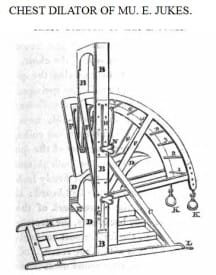 The chest dilator was a more formidable piece of equipment built upon a wooden chair with a convex back. The patient would sit in the chair, place her hands on the overhead bar, and draw a weight down and in front of her and thus strengthen the chest and shoulders.
The chest dilator was a more formidable piece of equipment built upon a wooden chair with a convex back. The patient would sit in the chair, place her hands on the overhead bar, and draw a weight down and in front of her and thus strengthen the chest and shoulders.
Hall exercise
Another approach to exercise encouraged otherwise indolent patients to engage in novel activities. A hall exercise 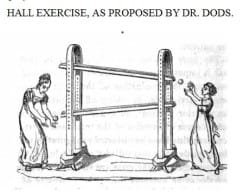 mechanism that involved rolling balls down an upper ramp to a partner who would catch them and return them to her partner via a lower ramp provided one such novel activity. By such means patients who might otherwise be reluctant would be encouraged to stretch their muscles and improve their health. (Corbould, H. , 1825)
mechanism that involved rolling balls down an upper ramp to a partner who would catch them and return them to her partner via a lower ramp provided one such novel activity. By such means patients who might otherwise be reluctant would be encouraged to stretch their muscles and improve their health. (Corbould, H. , 1825)
Posture Couch
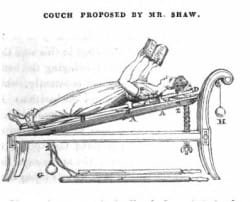 After such exercise, the use of a posture couch might be used that the spinal muscles could be relaxed and the patient enjoy a change of position. The patient would lie upon their back and her position adjusted by the rollers on the frame. At night, the contraption might be converted into a regular bed for convenience.
After such exercise, the use of a posture couch might be used that the spinal muscles could be relaxed and the patient enjoy a change of position. The patient would lie upon their back and her position adjusted by the rollers on the frame. At night, the contraption might be converted into a regular bed for convenience.
Bathing
Surprisingly, bathing, along with friction to the skin, was considered an essential element of beauty-training, necessary for removing impurities and improving the flow of blood in the skin. However, beauty seekers were cautioned to remember the dangers of indiscriminate cold bathing, especially for those who were of a nervous or weak constitution. Warm baths were thought to stave off the effects of aging and be of particular benefits to the skin, especially when aromatic herbs or substances such as borax were added to the water. For those for whom bathing was not practical or possible, sponging and the use of the ‘flesh brush’ might provide an adequate substitute.
Recipe books replete with recipes for soaps, washes, waters, potums, salves and the like were available for who sought chemical assistance in their pursuit of beauty. The next part of this series will examine the much debated issue of bathing in the Regency era.
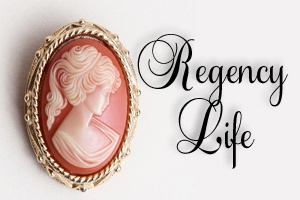
Articles in this Series
- Mistress of the Manor: Full-time working mother or lady of leisure
- To be an Accomplished Lady
- Defining Beauty in the Regency Era
- Improving upon Nature: Beauty Training in the Regency Era
- Men have Swords Women have Fans
- Schoolgirl Embroidery in Regency Britain by Julie Buck
Find more great content:

Like what you’re reading?
References
Andry, Nicolas. Orthopaedia: Or, the Art of Correcting and Preventing Deformities in Children . Vol. 1. London, 1743.
Buc’hoz, Pierre-Joseph. The Toilet of Flora Or, a Collection of the Most Simple and Approved Methods of Preparing Baths, Essences, Pomatums, Powders, Perfumes, Sweet-Scented Waters, and Opiates for Preserving and Whitening the Teeth, &c. &c. With Receipts for Cosmetics of Every Kind, That Can Smooth and Brighten the Skin, Give Force to Beauty, and Take off the Appearance of Old Age and Decay. For the Use of the Ladies. Improved from the French of M. Buchoz, M.D. London: Printed for J. Murray, Mo 12 Fleet-street and W. Nicoll, No. 51, in St. Paul’s Church Yard, 1784.
Corbould, H. The Art of Beauty, Or, The Best Methods of Improving and Preserving the Shape, Carriage, and Complexion ; Together with the Theory of Beauty. London: Printed for Knight and Lacey … and Westley and Tyrrell, Dublin, 1825.
Duties of a Lady’s Maid with Direction for Conduct and Numerous Receipts for the Toilette. London: James Bulock, 1825.
Green, Ruth M., The Wearing of Costume: The Changing Techniques of Wearing Clothes and How to Move in Them, from Roman Britain to the Second World War. New York: Drama Publishers, 1995.
Jeamson, Thomas. 1665. Artificiall embellishments. Or Arts best directions how to preserve beauty or procure it. Oxford: Printed by William Hall, amm. D.
Sanford, Victoria. “Public Reaction to Rising Waists During the Late 18th Century: Regency Fashion.” Jane Austens World. June 2, 2010. Accessed January 9, 2015. https://janeaustensworld.wordpress.com/2010/06/03/public-reaction-to-rising-waists-during-the-late-18th-century-regency-fashion/.
Sheldrake, Timothy. An Essay on the Various Causes and Effects of the Distorted Spine ; on the Improper Methods Usually Practised to Remove That Distortion ; In Which That Recommended by Mr. Pott Is Considered, and the Bad Effects of Vacher’s (commonly Called Jones’s) Spinal Machine Are Pointed Out: With the Description of an Instrument That Is Better Calculated to Remove Those Distortions than Any Hitherto Made Use Of, and That Will Not Be Productive of the Pernicious Consequences That Have Been Caused by Most of the Other Machines. To Which Are Added, Some Observations on the Treatment of Ruptures ; Intended to Shew the Impracticability of Curing That Disorder by Any Other Means than the Use of Proper Truffes, and the Superior Utility of the Improved Elastic Truffes with Flexible Pads, Made by T. Sheldrake, Jun. London: Printed for C. Dilly, in the Poultry ;, 1783.
Snively, John H. A Treatise on the Manufacture of Perfumes and Kindred Toilet Articles. Nashville: C.W. Smith, 1877.
The Art of Preserving the Hair on Philosophical Principles. By the Author of The Art of Improving the Voice. London: Printed for Septimus Prowett, Old Bond Street, 1825.
The book of health & beauty, or the toilette of rank and fashion: embracing the economy of the economy of the beard eye-brovs gums nails breath eye-lashes hands skin complexion feet ips teeth eyes hair mouth tongue, 8::- 81c. With recipes, and directions for use, of safe and salutary cosmetics— perfumes—essences-simple ‘vaters—depilatories, etc. And a variety “ select recipes for the dressing room of both sexes. 2nd ed. London: Joseph Thomas, 1, Finch Lane, Cornhill, 1837.
The Hand-book of Bathing. London: W.S. Orr, 1841.
The Hand-book of the Toilette. 2nd ed. London: W.s. Orr and, 1841.
The New London Toilet: Or, a Compleat Collection of the Most Simple and Useful Receipts for Preserving and Improving Beauty, Either by Outward Application or Internal Use. With Many Other Valuable Secrets in Elegant and Ornamental Arts. Containing near Four Hundred Receipts under the following General Heads. Perfumes Fine Waters Baths Cosmetics Conserves Confectionary Snuffs Pastes Wash Balls Scented Powders Pomatums Fine Syrups Jellys Preserved Fruits, &c. With Every Species of Cosmetic That May Be Useful in Improving Beauty, or Concealing the Ravages of Time and Sickness. To Which Is Added a Treatise on the Art of Managing, Improving, and Dressing the Hair on the Most Improved Principles of That Art. London: Printed for Richardson and Urquhart, under the Royal-Exchange, 1778.
The Toilette of Health, Beauty, and Fashion: Embracing the Economy of the Beard, Breath, Complexion, Ears, Eyes, Eye-brows, Eye Lashes, Feet, Forehead, Gums, Hair, Head, Hands, Lips, Mouth, Mustachios, Nails of the Toes, Nails of the Fingers, Nose, Skin, Teeth, Tongue, Etc., Etc., : Including the Comforts of Dress and the Decorations of the Neck … with Directions for the Use of Most Safe and Salutary Cosmetics … and a Variety of Selected Recipes for the Dressing Room of Both Sexes. Boston: Allen and Ticknor, 1833.
Turner, David M. Disability in Eighteenth-century England: Imagining Physical Impairment. New York: Routledge, 2012.
Turner, D. M. and Withey, A. (2014), Technologies of the Body: Polite Consumption and the Correction of Deformity in Eighteenth‐Century England. History, 99: 775–796. doi:10.1111/1468-229X.12087
Withey, Alun. “(Dis)ability? Living with Impairment in Early Modern Britain.” Dr Alun Withey. September 28, 2012. Accessed January 9, 2015. https://dralun.wordpress.com/2012/09/28/disability-living-with-impairment-in-early-modern-britain/.
Withey, Alun. “Sit up Straight! Bad Posture and the ‘Neck Swing’ in the 18th Century.” Dr Alun Withey. January 15, 2014. Accessed January 9, 2015. https://dralun.wordpress.com/2014/01/15/sit-up-straight-bad-posture-and-the-neck-swing-in-the-18th-century/.
Withey, Alun. “Steel and the Body in the Enlightenment:.” Dr Alun Withey. June 7, 2012. Accessed January 9, 2015. https://dralun.wordpress.com/2012/06/07/steel-and-the-body-in-the-enlightenment/.
by Maria Grace Copyright 2015, all rights reserved

Comments
Improving upon Nature: Beauty Training in the Regency Era — No Comments
HTML tags allowed in your comment: <a href="" title=""> <abbr title=""> <acronym title=""> <b> <blockquote cite=""> <cite> <code> <del datetime=""> <em> <i> <q cite=""> <s> <strike> <strong>